With Brisbane’s sunny climate, stunning scenery, cool culture and endless family attractions, here’s 10 reasons why Queensland’s largest city could be the perfect base for your next Australian holiday.
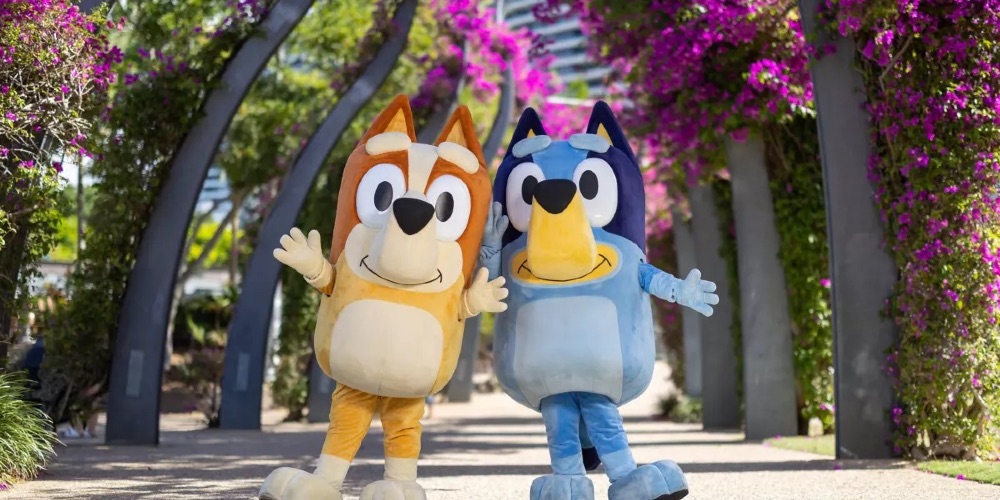
Bluey’s World is coming to Brisbane
While Sydney and Melbourne usually grab the headlines, Brisbane has been cementing its new status as Australia’s hippest city – and it’s also the fastest-growing, as reflected in a raft of new attractions springing up throughout the city. With Bluey’s World coming to the cartoon cattle dog’s hometown from 4th November, as well as new hotels and restaurants opening every month, Brisbane love is on the up. On top of that you’ll find a buzzing cultural scene, a thriving foodie paradise, many family-friendly festivals, and public events throughout the year.
Current buzz aside, Brisbane has always had plenty to offer families – it’s as much about the natural landscape and wholesome fun of hiking, beach trips and wildlife parks as it is about urban distractions and modern attractions. In other words, Brisbane is a destination which offers pretty much everything – a city break, beach break, family entertainment hub and educational nature trip all rolled into one. As they say in Australia: no worries.
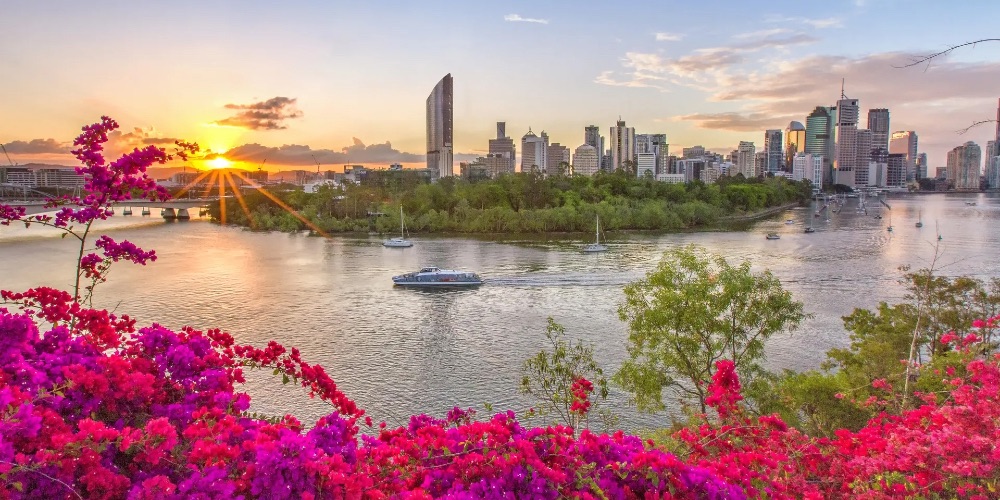
Brisbane is lovely in all seasons
2. It’s always the right time to visit Brisbane
Occupying a halfway point on Australia’s east coast in Queensland, subtropical Brisbane gets good weather all year round, so there’s really no bad time to go. Even the rainy season is comparatively dry, averaging just 10-12 downpours per month. With warm summers, mild winters and plenty of sunshine, each season has its own charms, with outdoor activities always on offer.
When are Brisbane’s seasons?
Spring: September to November, average temperatures 20-28°
Perfect for: A city in bloom, festivals, gardens
Brisbane blooms in spring, and it’s also jacaranda season: with the iconic purple flowers making stunning backdrops to the city’s parks and gardens – riverside New Farm Park and South Bank Parklands have some particularly lovely displays. Botanic gardens are perfect outings for this time of year, so combine a visit to Mt Coot-tha Botanic Gardens with a walk up to Mt Coot-tha Lookout for breathtaking city views, which are even more gorgeous during sunset.
Spring is when the brilliant Brisbane Festival happens, too, with free family events topped off by the Riverfire fireworks display over Brisbane River.
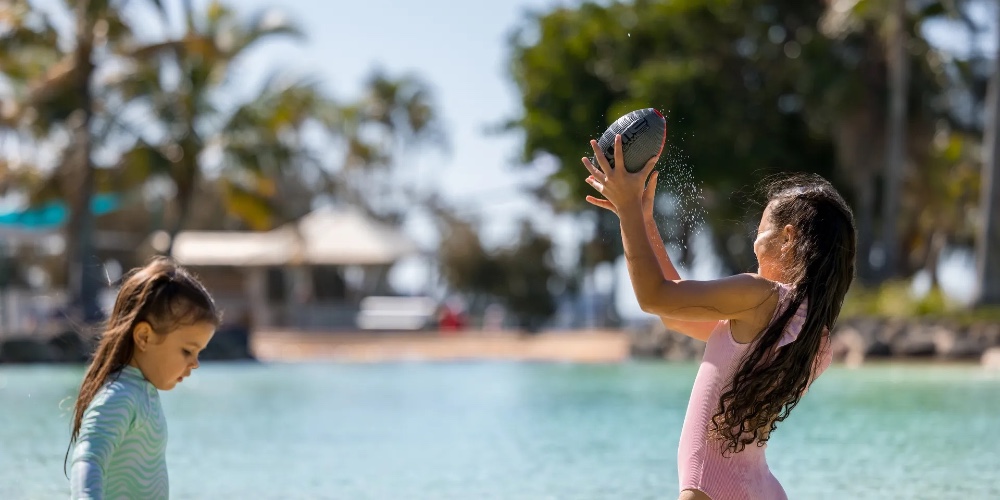
Splash time is all the time in Brisbane
Summer: December to February, average temperatures 22-30°
Perfect for: Beach trips, splash parks, festive cheer
Brisbane summers are humid, meaning beach time and ice cream are great ways to cool down: but you don’t need to leave the city to find somewhere to swim. Streets Beach at South Bank Parklands has a manmade lagoon surrounded by sandy shores and tropical gardens, with shallow water areas for kids – a lovely place to spend a few hours, and open throughout the year. And next door is Aquativity, a splash park with interactive water features for all ages, so there’s really no excuse not to get wet.
If you’re visiting Brisbane over the festive season, you’ll find a tree in King George Square, Christmas markets and light shows, and a New Year’s Eve fireworks display along the Brisbane River, which gets great views from South Bank, Kangaroo Point Cliffs, and Eagle Street Pier.
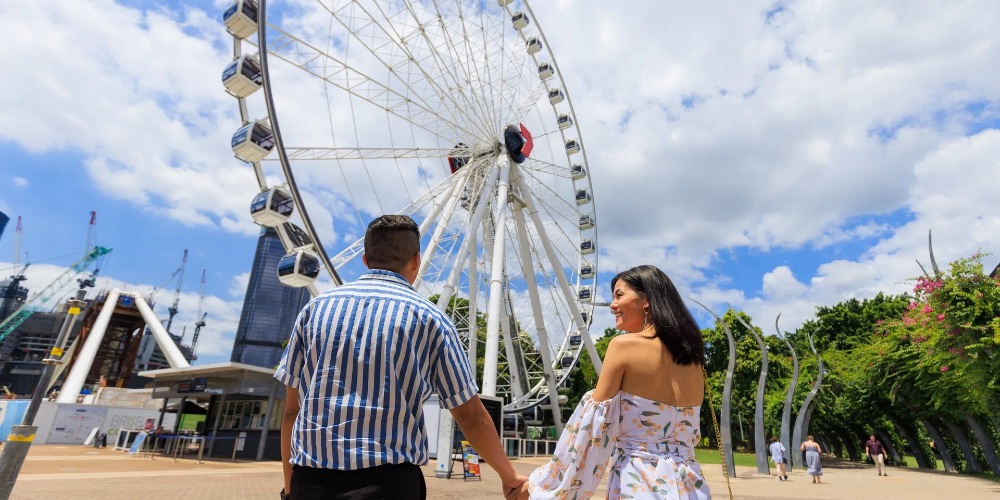
Find epic views at the Wheel of Brisbane
Brisbane’s seasons offer year-round family fun
Autumn: March to May, average temperatures 18-28°
Perfect for: Gardens, outdoor dining, hiking
Autumn in Brisbane has a relaxed vibe, but with lots going on. The riverside walkways are perfect for hiking and biking at this time of year: like the Kangaroo Point Cliffs trail, or the scenic Riverwalk from New Farm Park to Howard Smith Wharves. And if you’d prefer less strenuous views, take a ride on South Bank Parklands’ Wheel of Brisbane.
The Japanese Gardens at the Brisbane Botanic Gardens are especially lovely during autumn, and Brisbane’s outdoor dining scene is in full swing, with an open-air market, Eat Street Northshore, along the Brisbane River. It’s a mecca for foodies, with dozens of international food stalls housed in shipping containers. From Korean BBQ to decadent desserts, there’s something to bring a smile to every family member’s face, so make sure you arrive hungry.
Winter: June to August, average temperatures 16-22°
Perfect for: Whale watching, twilight markets, active sports
Winter in Brisbane is when you might get lucky and spot humpback whales travelling along the Queensland coast. Join a tour in Moreton Bay or the Gold Coast to see them breaching and playing in the water – an unforgettable family experience.
Winter is also when ice-skating rinks pop up around the city, including one at King George Square. There’s skating, live entertainment, great food, hot chocolate and mulled wine. There are several twilight markets at this time of year too, so grab dinner on the go at Brisbane City Twilight Markets. And active sports are perfect for this time of year – with less humidity, the city’s hiking and biking trails are an easier task.
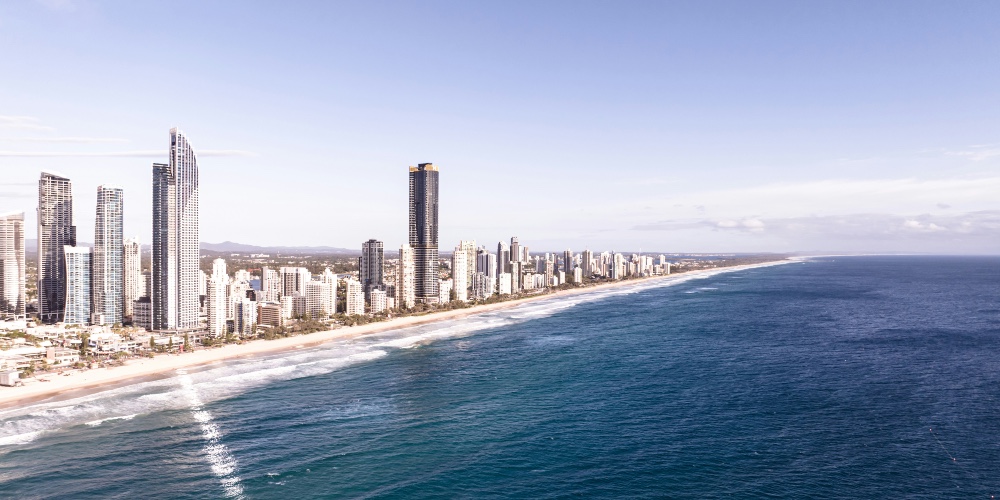
Gold Coast skyline
3. The buzzy beach playground of the Gold Coast
Brisbane is gateway to some of Australia’s most stunning coastline, including the world-renowned surfing capital of the Gold Coast. It’s around 80km south of Brisbane, and an hour’s drive along coastal highway. There you’ll find Surfers Paradise, big theme parks, the Currumbin Wildlife Sanctuary for up-close animal encounters, and, of course, incredible beaches. Broadbeach, Surfers Paradise, and Burleigh Heads all have lifeguards and calm, family-friendly water areas – Burleigh Heads is a great spot for both surf and safe swimming.
If theme parks are your thing, you’ll find plenty here. Warner Bros. Movie World has family-friendly rides, parades and live action shows, and character meets so your kids can say hi to Batman and Scooby-Doo. Sea World has animal exhibits, interactive experiences and rides – with the chance to meet penguins and get close to marine life in touch pools. Then there’s Australia’s largest theme park Dreamworld, with rides for all excitement levels and wildlife experiences with koalas and kangaroos. And the Wet’n’Wild waterpark brings the splashy fun of slides, wave pools and lazy rivers (see also WhiteWater World waterpark at Dreamworld).
If all that isn’t enough for energetic kids, then take in the views from the SkyPoint Observation Deck – this iconic skyscraper gives a bird’s-eye view of the Gold Coast. Or head into the Pacific Fair Shopping Centre for some retail therapy and souvenir browsing.
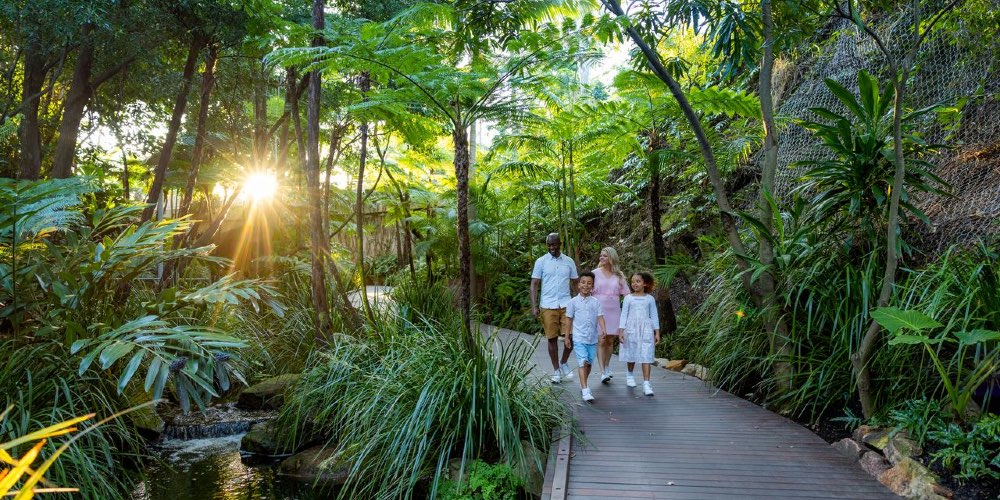
Rainforest Walk, Roma Street Parklands
4. Subtropical gardens and rainforest walks at Roma Street Parklands
The 16 hectares of Brisbane’s Roma Street Parklands are a perfect way to spend a family day in Brizzy. Don’t miss the Spectacle Garden in Colin Campbell Place – a world-class garden full of colourful and unique subtropical foliage and flowering plants. There’s also a Children’s rainforest walk too: on a warm day, you’ll find Eastern Water Dragons lounging around soaking up the UV rays on rocks and pathways. Free guided tours run throughout the year: to join one, register online ahead of your visit.
There are plenty of picnic spots and public barbecues around the Parkland, and playgrounds for the kids – all with incredible flora, fauna and skyline views. If you don’t want to bring food in, that’s no worries either – there’s a nice onsite cafe, The Garden Room.
5. Meet the marsupials at Lone Pine Koala Sanctuary
Brisbane is home to the world’s first (established in 1927) and largest koala sanctuary – Lone Pine Koala Sanctuary, home to 130 koalas and other unique Australian animals including kangaroos, dingoes and emus. It’s a lovely day out with kids, who can learn all about this beloved marsupial in a natural setting – and yes, it’s also possible to hug them. The sanctuary has a big focus on welfare and conservation, with an onsite wildlife hospital to help ailing wild creatures. There are daily ranger talks and interactive activities (you can go on a dingo walk, and learn all about this indigenous Aussie dog), so it’s an educational day out as well as a cute one.
The sanctuary is located in the leafy suburb Fig Tree Pocket, around 12km from the city centre. You can get there by car, public transport, or river cruise. One important thing to note is that the best time to discover active animals at the sanctuary is in the morning, so get there early.
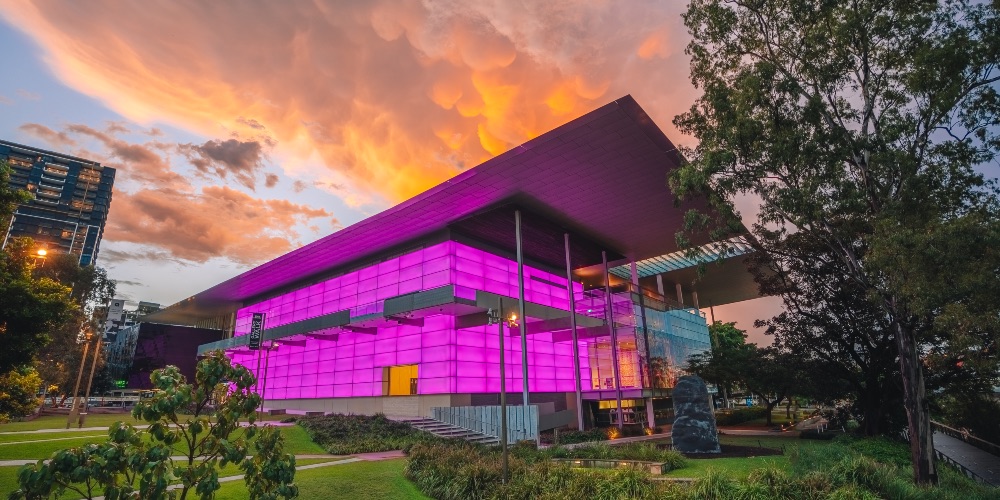
QAGOMA at sunset
6. You’ll find heaps of culture in Brisbane
We may have mentioned Brisbane’s growing status as Australia’s hippest city, and we meant it. With buzzy neighbourhoods like West End and Fortitude Valley and their vibrant street art, as well as a packed annual events schedule, culture is on every corner.
Older kids will love West End – with its quirky cafes, vintage shops, and independent theatres. It’s where you’ll find farmers markets, live music, and the best coffee. Fortitude Valley (‘The Valley’) is a nightlife and entertainment hub – with music venues, rooftop bars, and hip restaurants, another great vibe for older kids. And Howard Smith Wharves, located beneath the iconic Story Bridge, is Brisbane’s latest waterfront dining and entertainment centre, with riverside bars and restaurants, a relaxed feel and panoramic views.
Brisbane’s cultural heart of South Bank is all lush parklands, riverfront boardwalks, and open-air dining. It’s where you’ll find South Bank Markets: for artisan goods, street food, and live shows. The Queensland Museum, Queensland Art Gallery, and the Gallery of Modern Art (GOMA) are in South Bank too, with fun and educational exhibits for kids. Art-loving families should factor in a visit to the acclaimed QAGOMA (Queensland Art Gallery & Gallery of Modern Art): a dual-gallery complex with a focus on contemporary art from Australia, Asia, and the Pacific, which has a Children’s Art Centre, with interactive exhibits designed for kids, hands-on art projects and creative spaces.
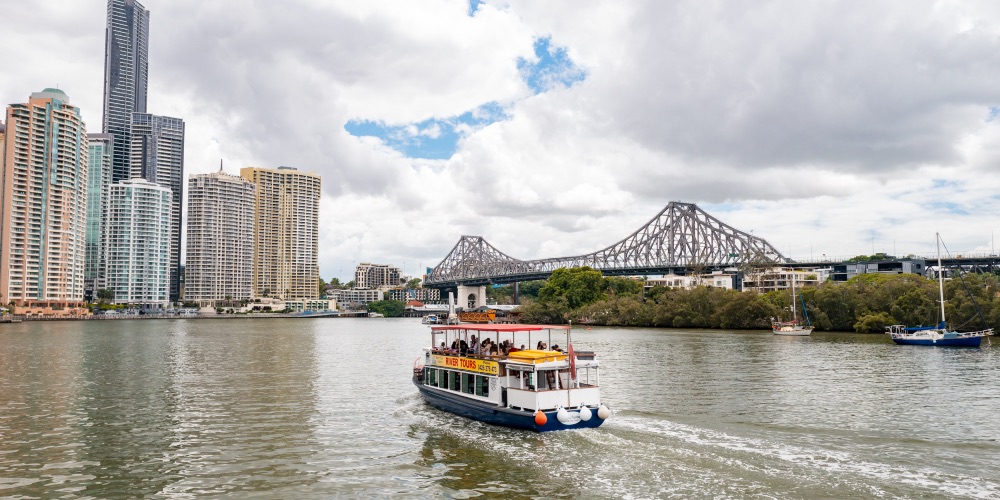
Cruising Brisbane River
7. Brisbane River is the connecting heart of the city
From fireworks displays to cruises, the cultural centre of the South Bank to the cliffs of Kangaroo Point, Brisbane River is where it happens. And there’s no better way to enjoy the sights than from a river cruise. The CityCat Ferry is Brisbane’s public transport ferry, and a great way to explore the river, with its hop on-hop off system meaning you can stop at South Bank, New Farm, or the CBD. Then there’s Kookaburra River Queens – a paddle steamer and floating restaurant, where your kids will love the old-world charm.
As previously mentioned, South Bank is great for families, with South Bank Parklands, Streets Beach lagoon, and riverside walks. There are also plenty of playgrounds, including the interactive Riverside Green Playground, perfect for little legs to stretch themselves in other ways while you have a rest.
Further along, Kangaroo Point Cliffs has lovely picnic spots, from which to enjoy beautiful views of the river and city. You can walk along the cliff paths, or go rock climbing with trained guides. Kayaking along the river from Kangaroo Point is a popular activity here too.
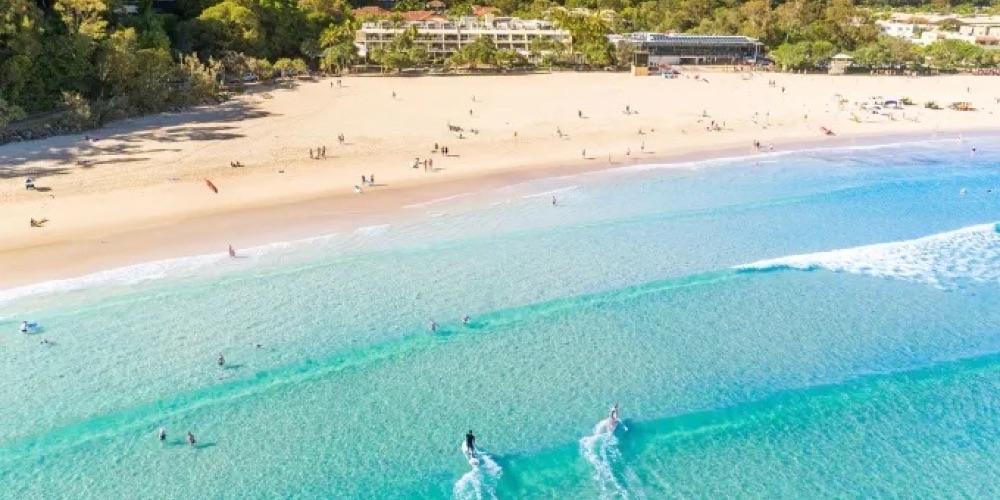
Noosa, Sunshine Coast
8. Everybody loves the Sunshine Coast
The Sunshine Coast is all about outstanding natural beauty, and where the pace is at relaxed as you like. It’s slightly further away, at around 1-1.5 hours north of Brisbane – but still very doable for day trips. With its lush national parks, fabulous beaches and the Steve Irwin-founded Australia Zoo, it’s perfect for families. And there’s plenty of surf here too – some of the east coast’s most renowned surf points sit on the Sunshine Coast, but there’s also plenty of calm waters giving opportunities for paddleboarding and kayaking.
Highlights for kids include Mooloolaba Beach, with its safe, patrolled waters and plenty of amenities. Then there’s Kings Beach, which has a water playground, tidal pool, and picnic areas. Noosa Main Beach has calm waves and ice cream shops, and the laid-back town of Noosa Heads, as well as Noosa National Park – with its beautiful coastal paths, and the chance to see koalas and dolphins in the wild.
Other Sunshine Coast attractions your kids will love include Aussie World theme park, which isn’t on the scale of the Gold Coast parks, but is great for younger kids, As well as Australia Zoo, you should check out the Mary Cairncross Scenic Reserve, and some of the area’s adventure and skate parks.
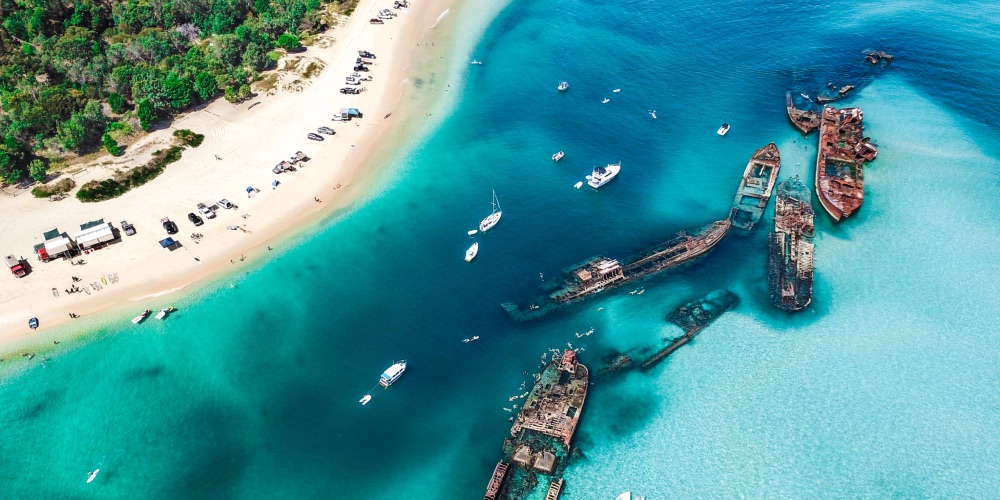
Tangalooma wrecks, Moreton Island
9. You can visit the white sand paradise Moreton Island in a day
There are beautiful islands just off the Brisbane coast where you’ll find glorious white sand beaches, a stunning array of marine life, and even shipwrecks. Go to Moreton Bay – around 20km from the CBD – to catch a ferry or water taxi over to Moreton Island (also known by its original name, Mulgumpin). You can do this via an organised tour, but it’s also really easy to do in your own 4WD, or via public transport.
Some of the best family-friendly beaches on Moreton Island are: Cylinder Beach, a patrolled beach which is great for swims and picnics, with gentle waves meaning kids won’t get knocked over; Main Beach, with bigger waves thus lots of fun to be had with a body board; and Frenchman’s Beach, a more secluded choice for a family day, with lots of rock pools to explore.
There’s plenty more on offer on Moreton Island for active families, including sand tobogganing, snorkelling at the Tangalooma Wrecks, and wild dolphin feeding at Tangalooma Resort. Plus, if you’re visiting throughout whale watching season, you must go to Point Lookout and try your luck – it’s known as one of the best land whale watch spots in the world.
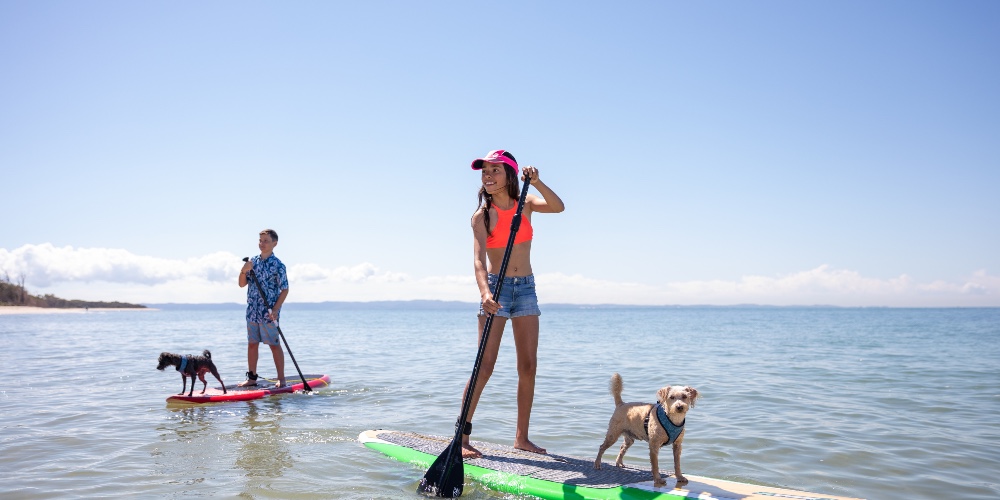
Paddleboarding at Bribie Island
10. Bribie Island – another Brisbane jewel, with a bridge
Bribie Island is just as pretty and fun to explore as Moreton Island – and is connected to the mainland via bridge, meaning no ferry required. Head to Woorim Beach, the island’s main surf beach, which is patrolled, making it super-safe for families. You’ll find plenty of room on the sands for swimming, surfing, and building sandcastles. On the other side of Bribie is Bongaree Beach, which is ideal for younger children as the waters are shallow and calm. Also there’s a pretty shaded park nearby with BBQ facilities and playgrounds.
Pumicestone Passage, on the same side as Bongaree, is a protected waterway where you can swim, fish, kayak, or take a boat cruise along the passage – which we recommend, if you like the thought of spotting dolphins, turtles, and dugongs. You can rent kayaks and paddleboards here too, or bring your own!
If there’s time, stop in at Bribie Island Seaside Museum, a small but fascinating museum located at Bongaree with interactive exhibits on the island’s history, including WWII involvement, local wildlife, and maritime heritage.
Useful information:
Brisbane Visitor Information Centre for more information and booking Brisbane attractions, or anything related to your trip. Located in Stanley Street Plaza on South Bank, you can also visit in person – they’re a helpful bunch.

